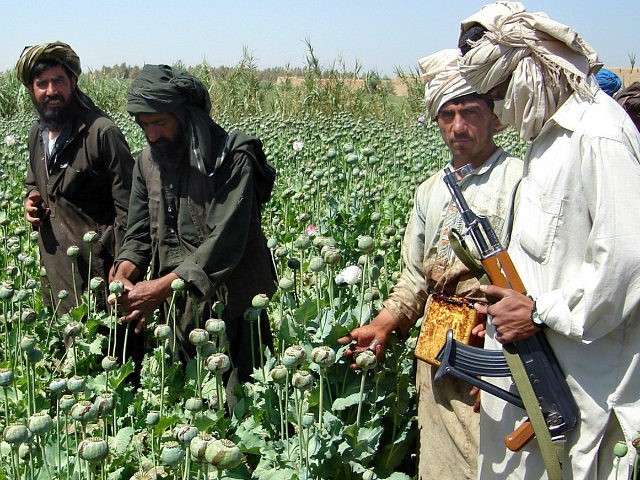U.S. airstrikes targeting drug labs in Afghanistan reportedly drove a Taliban commander in Helmand, the most opium-producing region in the world and one of the group’s major strongholds, to move heroin factories away from urban areas into the mountains to avoid detection.
Mullah Manan, the Taliban shadow governor in Helmand, indicated to the Guardian on Monday that “any Taliban who permitted” the presence of drug and heroin “facilities” in public urban areas “would also be punished” for placing local residents at risk of getting bombed by the U.S. military, the newspaper reports.
The Taliban commander noted:
Due to one [drug] factory hundreds of the public are at risk from bombings and missiles. Drones are roaming in the air and they have made men, women and children scared because of bombing. We must strictly explain to people that if they do not stop drugs factories in public houses they will go to jail.
Taliban-narco jihadists generate most of their funding for terrorist activities from opium and its heroin derivative.
Referring to a WhatsApp conversation between the Taliban shadow governor in Helmand, Mullah Manan, and his secretary, the Guardian points out.
The recording, which was verified by experts on the Taliban, provides a rare insight into their operations, and shows how the Trump administration’s looser rules of engagement in Afghanistan are shifting dynamics in the 17-year-old war.
Although America’s “mini-surge” has made little progress against the Taliban, according to a report from the US’s own watchdog released on Monday, Mullah Manan’s message suggests the Islamist movement fears local discontent as airstrikes target drugs labs in built-up areas.
Manan reportedly urged his troops to move their heroin facilities from urban areas to “mountains and valley sides.”
Since the U.S. military expanded its airstrike campaign against the Taliban’s top source of funding — opium and heroin activities — the terrorist group has criticized the move, claiming the Americans are striking civilians.
The U.S. military maintains that no civilian casualties have resulted from the anti-opium campaign, the Guardian notes, adding that the American air campaign may have targeted non-Taliban locals involved in the illicit drug-processing business.
Helmand is the “largest opium-producing province” in Afghanistan, the United Nations revealed late last year, citing the most recent data available.
Taliban narco-jihadists control or influence about 65 percent of Helmand province, located along the border with Pakistan, long accused by the Pentagon of backing the terrorist group.
The Taliban controls or influences more districts (nine of 14) in Helmand, the largest province in Afghanistan, than any other region, according to a U.S. watchdog agency.
Despite more than $8 billion devoted to counternarcotics operations in Afghanistan since the beginning of the war in October 2001, the country remains the top opium and heroin producing nation in the world.
Afghanistan produced up to an unprecedented 9,000 tons of opium last year alone, marking about a three-time increase from the 3,400 tons generated in 2002, the first full year of the U.S. occupation.
Marking a significant departure from the previous administrations last year, U.S. President Donald Trump authorized the American military to launch airstrikes against the Taliban’s heroin and opium operations, primarily concentrated in Helmand.
Taliban militants make more than 60 percent of their terrorist activity funding from the opium trade, data from the U.N. and the U.S. military shows.
U.S. Air Force Brig. Gen. Lance Bunch, the chief of air operations targeting insurgent revenue, told reporters in December 2017 that “almost $200 million” of the Taliban’s funding “comes from the narco-processing trade.”
The U.S. military has intensified airstrikes against the Taliban and other jihadist groups in Afghanistan under Trump’s watch.
Munitions dropped on terrorists since Trump took office (about 5,208) have exceeded those launched during the three years preceding his inauguration (2014, 2015, 2016) combined, U.S. Central Command (CENTCOM) data shows.
Trumps’ anti-heroin air campaign in Afghanistan has pulverized at least 73 drug labs worth $42 million since it began in November 2017, making a small dent in the group’s hundreds of facilities.
Rather than targeting all poppy farmers, the U.S. military focuses on opium activities directly linked to the Taliban, going after individuals involved in the heroin processing operations, the American armed forces have explained.
In Afghanistan, the crop is a significant livelihood source, “worth between U.S. $ 4.1 to 6.6 billion in 2017,” the U.N. reported last week.
Some U.S. officials have indicated the American military prefers more targeted bombing approach over using aerial spraying to destroy the opium crops

COMMENTS
Please let us know if you're having issues with commenting.